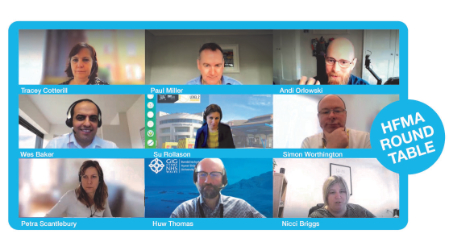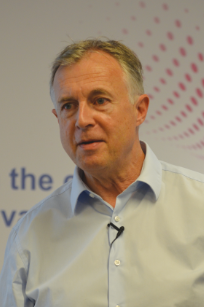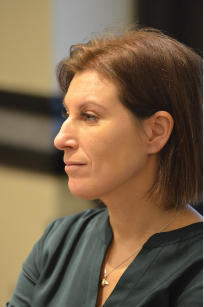Feature / The bigger picture
Improving population health – focusing on outcomes for entire populations and tailoring services to individual and group needs – is one of the core aims of integrated care systems. It means health services thinking about current and future health and care needs and working in partnership with other organisations to address the wider determinants of health.
But, while there is considerable support for the population health management (PHM) approach, which relies on the analysis of wide-ranging datasets, there are considerable challenges to putting it into practice.

Getting started is one of the key issues with the move to population health. This was where Su Rollason, chief finance officer at University Hospitals Coventry and Warwickshire NHS Trust and former system finance lead for the Coventry and Warwickshire integrated care system, focused the roundtable’s attention initially.
Wes Baker, director of strategic analytics, economic and population health management at Mersey Care NHS Foundation Trust, said the key decision locally was moving away from a pathway approach to one that looked at patients and service users more holistically.
For example, there was a 20-year life expectancy gap for mental health service users compared with non-mental health service users. These users were dying of physical health long-term conditions such as respiratory disease. And a pathway approach simply didn’t address the issue of multi-morbidity.
So the trust had gone down the route of segmenting its population into groups with common healthcare needs and risk-stratifying these groups.
While the overall goal was to take a whole population view, initially trusts had to narrow their focus, said Mr Baker.
‘We had to focus on two segments to be able to do something tangible on the ground,’ he said. ‘And this really started the conversation at a place level.’
The use of data to start conversations – and the fact that it was the conversations and not the data itself that led to change – was to become a common theme for the discussion.
Andi Orlowski, director of the internal NHS consultancy the Health Economics Unit, said one of the important aspects of segmentation models, such as Bridges to Health, was its focus on whole populations. This included healthy people today who may be sick tomorrow.
‘We’ve captured data about activity that has already happened in great detail, but what about the well people?’ he asked. ‘The 45-year-old who hasn’t seen their GP for a decade, but has been gaining weight over time, with a more stressful job and drinking more – how do we know more about them? That is what we mean by whole population. How can we predict who is going to be sick tomorrow?’
Nicci Briggs is director of finance of Leicestershire, Leicester and Rutland Clinical Commissioning Groups, which have recently implemented a primary care funding formula based on patient need, aiming to reduce health inequalities across the system.
The funding model is based on patient-level data and aims to better match primary care allocations with local health needs. However, the data was the starting point.
‘We spent a couple of years improving the data that we did have in terms of population health and all its component parts,’ she said.
‘And we worked with Johns Hopkins on its Adjusted Clinical Group (ACG) system, which allows you to combine primary care, acute and public health data together and then identifies risks and tracks patients over a period of time – projecting forward rather than looking back,’ she said. ‘This allows you to cluster on morbidity rather than defined diseases, which is the way the health service works at the minute. In addition, our model incorporates list turnover, deprivation and communication issues, which can increase the amount of time you need for health appointments.’
Data has also been the starting point for Barking, Havering and Redbridge University Hospitals NHS Trust. Petra Scantlebury, the trust’s assistant director of finance for strategy and planning, said the North East London system had recently established a financial intelligence workstream to look at both allocative and technical efficiency.
‘It has two key objectives – to build intelligence to inform the allocation of funding to maximise outcomes for our population,’ she said. ‘And once those resources are allocated, the aim is to understand how they are used and to inform improvement.’
Working in partnership is key to addressing the wider determinants of health according to Paul Miller, non-executive director of Salisbury NHS Foundation Trust. ‘So a starter for 10 has to be to engage your local authorities around their joint strategic needs assessments,’ he said. ‘If we don’t, we’ll have a very irritated set of public health colleagues. It has to be about what adds value to the population, not just what adds value to the patient.’
Tracey Cotterill, a former NHS finance director and Civica’s managing director of population health intelligence, said systems could also start by looking at who is missing from referrals and attendances, or showing up in a later stage of disease development.
‘In one London system, analysis of the data identified that a significant proportion of cancers among the more deprived cohorts of their population were being diagnosed in the emergency department,’ she said. ‘We need to ask if we are seeing the proportions of people we’d expect to see in each category. And when we are late with a diagnosis, what are the common denominators and how can we use that information to enable earlier diagnosis in those cohorts in future?’
Huw Thomas, director of finance of Hywel Dda University Health Board, called for a focus on place. ‘Understanding the characteristics of communities will be really important in this,’ he said. ‘We need to start broad and work down.’ But he warned that this needed to go beyond postcode level. ‘You ultimately have to take it down to households,’ he said.
‘In Hywel Dda, we have areas where the legacy of old, heavy industry remains; and then we have areas of remote rurality and the drivers of deprivation are very different.’
Health systems should also beware the ‘tyranny of the average’ – for example, pockets of deprivation are often found in rural areas, but can be more hidden than in urban areas.
Data played a part in understanding communities, but continuous engagement and conversations were also vital. Mr Thomas added that people would respond differently to different interventions. ‘So, we need to think more creatively about targeting the individual drivers for people,’ he said.
Mr Baker also reminded the roundtable that health bodies’ workforces also provided a place to start. ‘A third of our staff live in the most deprived communities,’ he said. They will face many of the same access and lifestyle challenges as others in those areas. They also tended to have the highest sickness rates, so focusing on improving their health could have a double benefit.
Mr Orlowski suggested that impactability modelling could help with understanding who was most likely to respond to specific interventions.
‘This is where primary care networks and people understanding their local populations, and staff, will make the real difference in picking the right intervention,’ he said.
Finance data
Ms Rollason asked if areas had specifically used finance datasets as a starting point for improving population health.
Paul Buss (pictured), director of clinical strategy for Powys Teaching Health Board, said that he moved from a more traditional acute focused provider to a primary care, community, integrated provider, as it looked at things from a different, population perspective.
‘Initially I looked at finance within primary care,’ he said. ‘If you delve into various levels of practice-based finance, at cluster finance level or practice level, or even dispensing logs at a local level, from a clinical perspective, you recognise clinical behaviours. And the variation evident across a region in the primary care finance data is of great interest.’
Dr Buss said the existing data sets were ‘rich pickings’. ‘But we’ve got to be prepared to have good data sharing agreements. And we’ve got to understand how we will look at that data, because someone with a secondary care view will see particular issues, while someone with a public health population lens will start to look at it from an allocative value perspective.’
Ms Scantlebury highlighted the significant amount of costing data in secondary care. ‘So we know we are able to evaluate cost effectiveness,’ she said. ‘We can look at cost efficiency. But can we answer the question of whether or not the needs of our population have been met? The answer is probably not, because the main assessment criteria around population health management are more ethical than economic in nature. We need more information around reliable assessment of need than just the finance data sets.’
Simon Worthington, finance director of Leeds Teaching Hospitals NHS Trust, argued that there were opportunities to put a public health lens onto provider costing data.
The trust’s costing team has developed a system combining its patient-level costing data with trust-collected comorbidity and lifestyle information. It has also pulled in index of multiple deprivation data from the Office for National Statistics.
‘So, for instance, we’ve got analysis of where respiratory conditions are coming from and the extent of heating in houses in those areas,’ he said. ‘And yes, you can see there are more people with respiratory conditions coming from areas where there is inadequate heating.’
While this may seem obvious, it helps to show the cost of treating the symptoms rather than the cause, and creates opportunities for discussion about what could be done to avoid the conditions developing in the first place.
‘In the acute sector, if we have well-developed costing systems, there’s a whole wealth of analysis and insight we can get.
‘We can pick out frail patients or those consuming huge chunks of resource and start to discuss if there are better ways of managing those situations,’ Mr Worthington added. ‘That is really powerful and it is really engaging clinicians in my trust.’
Information governance (IG) is often raised as a concern for population health management with obstacles to be overcome in terms of data sharing. However, Mr Baker suggested that many of the problems were cultural. ‘I don’t think there is a major issue around information governance,’ he said. ‘Yes, we have to do the data protection impact assessments to get the data flowing. But the harder part is the culture – getting people to give you access to the data. They will put barriers up where they think there is an IG issue, when there isn’t. So winning hearts and minds is key – demonstrate that everyone will benefit from this data. We’ll take it, but we will give it back to you and it will enrich your job.
‘I can do the legal side and show them the governance will be done properly, but the cultural part is harder. So perhaps there is a national role to engage with local authorities about why we need this intelligence.’
Finance framework
The roundtable also discussed how a financial framework could support a new focus on population health. Ms Briggs said a step change in resource allocation was needed.
‘All our long-term plans will talk about a left-shift and prevention, yet when you look at the financial history, you will see high growth in acute and below-inflation increases in community and primary care,’ she said. ‘So we put our stamp on a strategic vision, but what we do with the financial resources is the complete opposite, because we can’t get out of that cycle.’ She said the service needed to refocus on pathway costs.
‘For example, we have found that our musculoskeletal pathway is our most expensive pathway, because it is largely in the acute sector,’ she said.
‘And when you put a population health spin on it, it is largely the people in the affluent areas, so we are not even getting to the deprived areas. And we wouldn’t understand this without pathway costing. We have a responsibility to start to collect and analyse data at a pathway level.’
Mr Worthington agreed with the need to invest upstream of acute services. But he said this didn’t often lead to reduced pressure on acute beds, given the levels of pent-up demand. And there could be difficulties with stranded capacity and costs. ‘This is what makes this so challenging to get off the ground. That is the real tension and the real debate we need to get into,’ he said.
‘We need to eliminate some of the waste in our existing systems to give us some discretionary money to channel into some of these longer term challenges.’
He suggested that an aligned incentive contract in Leeds had provided a mechanism to move towards changes in allocation. This committed to growth for the acute sector, recognising that demand would not turn off overnight. But it also delivered higher growth to other parts of the pathway.
This gave a clear direction of travel, while providing the acute hospital with some financial security. It was then free to make pathway changes without losing funding, which was a characteristic of previous payment by results-type contracts.
‘I’d encourage us not to come up with an overly complex payment system to support this agenda. Let’s keep it simple,’ he said.
‘It’s about aligning behaviours and incentives,’ said Mr Miller (pictured). ‘The biggest challenge in my hospital isn’t money, it is a shortage of workforce. So on an individual care management level, anything that we can do to get the same or better outcomes through fewer interventions is great.’
But he said some key principles were needed about the financing of service change. So, a hospital shouldn’t be left with stranded costs and be expected to eliminate them overnight.
‘Variable costs should move with the service, but fixed and semi-fixed costs need to be managed over different time periods,’ he said. ‘As a profession, it is our role to set up some rules of engagement around financing service change.’
Mr Orlowski said there was a role for the centre. ‘If the NHS expects us to make these changes, you need to be given freedom from the very top,’ he said. ‘If they believe in us dealing with the wider determinants of health, which can take years if not decades to have an effect, they need to create a system that allows finance professionals to have these conversations and move money appropriately.’
Leap of faith
Ms Briggs called for a ‘leap of faith’ on making some of the changes and targeting the benefits. ‘It is a bit like some of the digital work – you’re not going to build a case for change based on our usual three- to five-year review of outcomes,’ she said. ‘We need to improve our measurement of outcomes and establish a baseline of our population health metrics.
‘Then we can consider what we are trying to achieve and track that. Some of the population health outcomes won’t be immediate, but you can track some of them.’
She suggested that tracking cancer screening numbers by deprivation areas, especially where English isn’t the first language, could lead to a quick turnaround in those metrics.
Echoing Mr Miller’s comments about workforce being the main challenge, Ms Cotterill said PLICS data could also provide a window on resource consumption as well as pounds spent. ‘As a finance director, I can remember people coming to me for extra funding to meet service demand,’ she said.
‘But if you instead ask them to identify the clinicians they need, you can then prioritise against the resources actually available. Sometimes, no matter how much money is available, it just isn’t possible to secure the resources.’
This could be really powerful at a system level. ‘Maybe we need to think differently,’ she said. ‘Rather than moving the money around, we need to share the resources between us in a different way. And patient-level cost data can help you to see the resources, including staff numbers, being used in the total care of the patient.’
In summing up the discussion, Ms Rollason (pictured) said there was clearly a huge financial leadership role in moving towards a greater population health focus. ‘But there is also a technical role. So it seems that the finance function is pretty central to this,’ she said.
‘We have lots of data, including some really rich costing data, and that will play a crucial part in informing decisions. And information governance maybe isn’t the barrier that people think it is,’ Ms Rollason added. ‘The data is there to influence and help change behaviours, so the key is engagement – both at a leadership and at a clinical level.’
System opportunity
 Closer system working may provide opportunities to focus on populations and whole patient pathways, rather than looking at the secondary care pathway in isolation from community or primary care services. Wales has been operating a planned integrated system structure for a number of years. ‘One thing we’ve started to explore at the population level is how to take the allocation that is given to us and distil it down to sub-parts of the system – to the counties and clusters,’ said Mr Thomas. ‘We want to understand what those allocations look like versus the resources consumed at that level.’
Closer system working may provide opportunities to focus on populations and whole patient pathways, rather than looking at the secondary care pathway in isolation from community or primary care services. Wales has been operating a planned integrated system structure for a number of years. ‘One thing we’ve started to explore at the population level is how to take the allocation that is given to us and distil it down to sub-parts of the system – to the counties and clusters,’ said Mr Thomas. ‘We want to understand what those allocations look like versus the resources consumed at that level.’
He acknowledged that this had not yet led to much change. ‘But it has helped us to understand what is driving our deficit and our financial challenges,’ he said.
The health board has also looked at the patients consuming the highest level of resources to understand their journeys over the whole pathway and their lives outside of being a patient.
‘We’ve also got 10 pathways where we are measuring patient reported outcome measures (PROMs) at scale,’ he said. ‘That is the other bit of the equation – the impactful bit of the equation that we’ve missed in the past. Bringing that in has been helpful. But one of the challenges that we’ve now got is comparing apples and pears across PROM measurements.
‘So we are looking at how we can use datasets such as EQ5D to understand the impact we are having on quality adjusted life years. This will enable us to start to compare, at a population level, the impact of investment across conditions and up and down the pathway.
Dr Buss echoed Mr Thomas’s comments about using the EQ5D. ‘It is very easy to collect and it can be done by a GP, a nurse, even a carer – anyone with patient contact,’ he said. ‘If you collect it across a whole system, you will start to get trends about population health and wellbeing, mobility, anxiety, pain control – all in one simple validated metric.’
He added that there were many care models that had been shown to deliver value, by moving interactions from secondary care into community settings, for example. But he acknowledged that existing finance data sets only reveal a partial story. For example, investment in addressing adverse child events would certainly deliver societal benefits, which would be seen outside of health, in social care, education and crime or antisocial behaviour.
‘So we should start with the things that we know we can do – that fit more with our traditional approach and traditional financing arrangements,’ he said. ‘But it is through the data-sharing potential we have across systems that we can start to ask some really interesting questions at a whole system level.’
Mr Miller stressed again that the real value of data was to start conversations, particularly among clinicians. ‘There are lots of financial datasets around and a wealth of information. But my experience has shown me that conversation is the powerful thing, not the data,’ he said.
He mentioned the HFMA Healthcare Costing for Value Institute and Future-Focused Finance’s Engagement Value Outcome initiative to promote collaborative working between clinical and finance teams using patient-level cost (PLICS) data. He said that once clinicians and others started to understand the value of the patient data, it did lead to changes in behaviour. ‘We might not need other data sets,’ he said. ‘But are we using the ones we’ve got well enough? By sharing the information we already have, and facilitating conversations with the people who really make a difference if they change their behaviour, we can make a difference.’
Ms Cotterill agreed that PLICS data was a good place to start ‘for analysing what is being spent as a system, not just as a hospital’. The National Cost Collection programme already involves acute, mental health and ambulance service trusts and this year community providers will join the mandatory submission.
Civica offers a platform that will bring this data together along with public health data on issues such as air quality and housing. This type of holistic analysis would be vital for systems, she said.
She added that when individual organisations only looked at their own pathways, there was a danger that overall patient care wasn’t optimised and patients could be bounced around the system, delivering sub-optimum outcomes and overall higher costs. ‘It is about understanding the total cost of a pathway and the value that we are deriving from it.’
However, the sheer volume of data involved can be intimidating and it can be hard to know what questions to ask. ‘So what we’ve tried to do is to collate the data in such a way that it presents insights rather than just giving data back,’ she said, adding that the system used artificial intelligence and machine learning to hit upon this demographic insight.
Participants
- Wes Baker, Mersey Care NHS Foundation Trust
- Nicci Briggs, NHS Leicestershire, Leicester, and Rutland CCGs
- Paul Buss, Powys Teaching Health Board NHS Trust
- Tracey Cotterill, Civica
- Paul Miller, Salisbury NHS Foundation Trust
- Andi Orlowski, Health Economics Unit
- Su Rollason (chair), University Hospitals Coventry and
Warwickshire NHS Trust - Petra Scantlebury, Barking, Havering and Redbridge University Hospitals NHS Trust
- Huw Thomas, Hywel Dda University Health Board
- Simon Worthington, Leeds Teaching Hospitals NHS Trust
Related content
We are excited to bring you a fun packed Eastern Branch Conference in 2025 over three days.
This event is for those that will benefit from an overview of costing in the NHS or those new to costing and will cover why we cost and the processes.